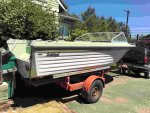fiberformbl
Cadet
- Joined
- Nov 14, 2010
- Messages
- 15
Hello,
I joined this forum a few years ago when my Fiberform 17 ft open-bow tri-hull cracked its transom. Investigation showed that the transom and stringers were rotten - all the wood in the boat needed to be replaced - big job. I pulled the cap and started demolition, but then quit and it has been sitting for years - I recently came to terms with the fact that I would never finish this project, but I wanted to get back on the water (without spending a fortune). I had a trailer and an outboard motor, so I started looking for hulls that might work. Since I was looking at cheap stuff, the chance of rotten wood was high, so I was drawn to boats that were made without (or with less) wood to rot. And after having a tri-hull and realizing how bad it is in even a little chop, I wanted a V-hull.
I came across this Bell Boy Bonneville for $10 - no wood in the stringers, and the transom was really solid. So this is my new project. I read Pusher's post on his Bell Boy restoration - he did a great job on the restoration and the description, and much of what he did fits my thinking too. My boat even has the same color scheme as Pusher's, but is a little longer at 19.5 ft.


I will try to contribute by posting photos of the work, but I REALLY hope to get input from people on fiberglass work and engine controls - I will start posting soon. Maybe a little unusual, I am going to get this in running shape first and then go back and fix things up. This is in part because I want to be on the water, and in part because my wife wants me to prove that it floats before I invest any money in fixing it up - of course it will float, but I suppose she is challenging me to get it working after our other boat sat broken for six years. Whatever - I want to be on the water so I will humor her. Some questions coming up soon about Bell Boy structure, since floor deck is already removed and will be one of the first fixes.
I joined this forum a few years ago when my Fiberform 17 ft open-bow tri-hull cracked its transom. Investigation showed that the transom and stringers were rotten - all the wood in the boat needed to be replaced - big job. I pulled the cap and started demolition, but then quit and it has been sitting for years - I recently came to terms with the fact that I would never finish this project, but I wanted to get back on the water (without spending a fortune). I had a trailer and an outboard motor, so I started looking for hulls that might work. Since I was looking at cheap stuff, the chance of rotten wood was high, so I was drawn to boats that were made without (or with less) wood to rot. And after having a tri-hull and realizing how bad it is in even a little chop, I wanted a V-hull.
I came across this Bell Boy Bonneville for $10 - no wood in the stringers, and the transom was really solid. So this is my new project. I read Pusher's post on his Bell Boy restoration - he did a great job on the restoration and the description, and much of what he did fits my thinking too. My boat even has the same color scheme as Pusher's, but is a little longer at 19.5 ft.


I will try to contribute by posting photos of the work, but I REALLY hope to get input from people on fiberglass work and engine controls - I will start posting soon. Maybe a little unusual, I am going to get this in running shape first and then go back and fix things up. This is in part because I want to be on the water, and in part because my wife wants me to prove that it floats before I invest any money in fixing it up - of course it will float, but I suppose she is challenging me to get it working after our other boat sat broken for six years. Whatever - I want to be on the water so I will humor her. Some questions coming up soon about Bell Boy structure, since floor deck is already removed and will be one of the first fixes.


























